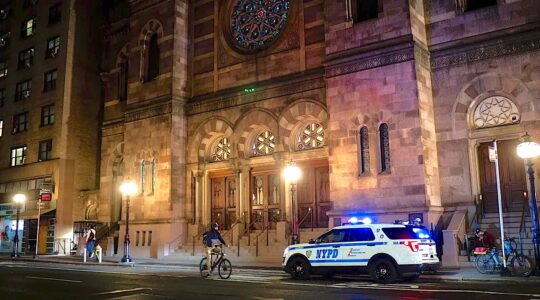In Israel, finding an affordable summer rental near the beach is about as easy as finding a rent-controlled apartment in Manhattan.
Launching my search right after Passover — and cognizant of the fact that a traditional hotel would insist we book two rooms for our family of four — I headed directly to the popular, less-expensive suite hotels that cater to families, but they were already booked by Israeli and European tourists.
Then I recalled that Caesarea, a very quiet, very upscale bedroom community halfway between Tel Aviv and Haifa, has a stunning ancient port, a golf course and beautiful beaches and a sprawling complex of vacation rentals.
A handful of the apartments at the Neot Golf Holiday Village were still available. The tastefully furnished two-bedroom apartment we booked featured a kitchen (which we kashered), a living room and small terrace, all for a reasonable $1,300/week plus electricity.
While it was tempting to spend most of our time at the resort, which offers covered swimming pools, tennis and racquet-ball courts, a gym, playgrounds and a miniature golf course (though no restaurant or mini-market), we were determined to explore the region.
Our first stop was the Port, which features archeological remnants of the port city built by Herod the Great just over 2,000 years ago, and which served as a hub in the Roman Empire. It was also an important Byzantine city and it was a feature of the Crusades.
Alongside the archeological park is a beachfront promenade featuring several good restaurants (most non-kosher), bars, fine boutique shops and vendors.
The Port also features one of the best-maintained beaches in Israel. For about $20/person (after 5 p.m., entrance is free), we spent hours in a protected cove in water as warm and calm as bath water. The seabed has rocks, so water shoes are recommended. The waves are wilder at Caesarea’s free beach, in the shadow of an ancient aqueduct.
The next day we headed for Haifa, the capital city of the north, about a 45-minute drive away. With only one day to explore, we focused on two sites: the Bahá’í Gardens and the science museum.
A UNESCO heritage site, the Gardens’ majestic grandeur takes your breath away. Comprised of landscaped terraces that ascend Mount Carmel, they are topped by a golden dome called the Shrine of the Báb, the grave of the Prophet-Herald of the Bahá’í religion. (There is also a (flatter) Baha’i garden in the city of Akko. Climbing the Haifa garden is exhausting but worth the effort.)
Madatech, The Israel National Museum of Science, Technology and Space, was the perfect place to bring the kids on a hot summer day. Totally hands-on, the museum entices visitors to explore the science behind not only waves and space flight, but magic tricks as well (you can spread out on a bed of nails) and energy (peddling a stationary bike causes objects to move).
The museum also features a state-of-the-art outdoor science play park, including a stationary helicopter kids can pilot.
Support the New York Jewish Week
Our nonprofit newsroom depends on readers like you. Make a donation now to support independent Jewish journalism in New York.
Craving another beach day, we drove from Caesarea to Hof Dor, a 15-minute drive up the coast. Many consider it the best, most beautiful beach in Israel, and for good reason. For just $3 per adult (kids under 12 are free), we entered a world of immaculate sandy beaches and protected coves.
The water, which was as warm and almost as clear as the Caribbean’s, was so shallow, young children were able to walk (accompanied of course) to a small nearby island. Protected from the harsher sea beyond, the coves are perfect for swimmers and non-swimmers of any age.
It’s best to arrive early, when it’s still possible to find room under the beach’s many thatched sun-protectors (bring your own picnic, since the only available food is expensive and greasy). It’s possible to rent a beach chair for about $2.50, half of which will be refunded upon return.
There is a variety of beachfront and other types of accommodations in the area (which includes nearby Hof Nahsholim, which has a hotel), some quite affordable, some more expensive. The Dor Holiday Village Resort for example, offers 45 small, simple “igloos, log cabins and a camping grounds.” Tip: book by late winter.
A trip up Israel’s mid-northern coast wouldn’t be complete without spending at least a day in Zichron Yaakov, just a few minutes’ drive from Hof Dor.
Founded in 1882 and perched on a mountain, the tiny community floundered until the philanthropist Baron Edmond de Rothschild took it under his wing and financed agricultural initiatives, most notably vineyards. Today, the town boasts several of the gentrified old houses alongside handsome contemporary homes.
The center of life in Zichron revolves around Ha-Nadiv and Ha-Meyasdim streets, where the feeling of old-world charm is reinforced by the presence of art studios and galleries, little restaurants and cafés.
The town’s award-winning Tishbi Winery (04-638-0434) offers wine and chocolate tastings and restaurants; the even better-known Carmel Winery has a wine shop, a restaurant, and two tasting rooms in underground cellars.
Carmel offers winemaking tours, wine workshops and “tutored tastings” for groups of 10 or more people (reservations are a must; 04-6391788).
Israel history buffs should check out the Museum of the First Aliyah, which presents the wave of immigration to Palestine from 1882 to 1903; and the Beit Aharson Museum, which focuses on the pre-state NILI resistance movement.
If we’d had another week, we would have explored the Arab-Jewish city of Akko, with its marvelous Old City, the Ein Hod Artist Village, and some of the country’s beautiful national parks, including the Hula Valley Nature Reserve (bird watching, bike rentals).
Our week left us refreshed and aching to return. Next time, I’ll book earlier.
Support the New York Jewish Week
Our nonprofit newsroom depends on readers like you. Make a donation now to support independent Jewish journalism in New York.
The New York Jewish Week brings you the stories behind the headlines, keeping you connected to Jewish life in New York. Help sustain the reporting you trust by donating today.




